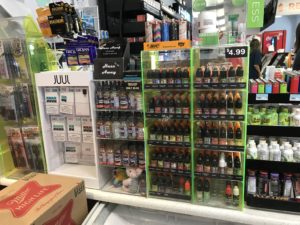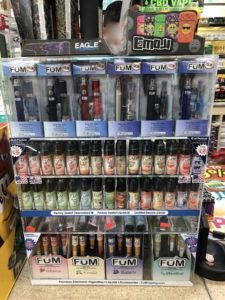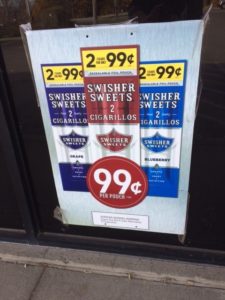Welcome to CounterTobacco.org’s “News and Research Roundup!” Each month we post a summary of the latest research, reports, and news stories on counteracting tobacco product sales and marketing at the point of sale (POS). Keeping up with what’s happening in the POS movement all across the country can help you choose policies and strategies that work best for your community. New research can help provide support for your work and evidence for the importance of the “War in the Store.” Have a story you don’t want us to miss? E-mail it to us!
New Research
E-Cigarettes
- Young and youth adult use of pod-based electronic cigarettes from 2015 to 2019: A systemic review, JAMA Pediatrics
- This systematic review of 35 articles, published between 2015 and 2019, reviewed the product design, biological effects, marketing tactics, social media presence, and youth perceptions of pod-based e-cigarettes, such as Juul, Suorin, and Vuse Alto. The researchers determined that these products evolved in design over the years to
 increase nicotine delivery and that adolescents who used pod-based e-cigarettes, compared to other e-cigarettes, were more likely to vape daily and exhibit more nicotine dependence symptoms. The research also evidenced that these products were extensively marketed on social media to specifically target youth and young adult consumers. Lastly, the researchers’ synthesis of publications found that young adult consumers of pod-based e-cigarettes reported top reasons for use as social approval, convenient product features, and user-friendly design. Learn more about e-cigarettes at the point of sale and youth access to tobacco products.
increase nicotine delivery and that adolescents who used pod-based e-cigarettes, compared to other e-cigarettes, were more likely to vape daily and exhibit more nicotine dependence symptoms. The research also evidenced that these products were extensively marketed on social media to specifically target youth and young adult consumers. Lastly, the researchers’ synthesis of publications found that young adult consumers of pod-based e-cigarettes reported top reasons for use as social approval, convenient product features, and user-friendly design. Learn more about e-cigarettes at the point of sale and youth access to tobacco products. - News story: Juul-type e-cigarettes may be especially addictive for teens: Study, U.S. News & World Report
- This systematic review of 35 articles, published between 2015 and 2019, reviewed the product design, biological effects, marketing tactics, social media presence, and youth perceptions of pod-based e-cigarettes, such as Juul, Suorin, and Vuse Alto. The researchers determined that these products evolved in design over the years to
- Prevalence of using pod-based vaping devices by brand among youth and young adults, Tobacco Control
- From December 2018 to January 2019, researchers collected data from 2,000 American youth (ages 15-17) and young adults (ages 18-24) about their current use of varying e-cigarette brands. In the entire sample, 16.3% of youth and 20.9% of young adults reported past 30-day use of any e-cigarette brand. Broken down by brand, prevalence of past 30-day use was highest for Juul with 12.9% of youth and 18.1% of young adults reporting use, while 4.4% of youth and 6.7% of young adults reported past-30 day use of Suorin, and 2.1% of youth and 6.2% of young adults reported past 30-day use of Vuse. The prevalence of using Juul or Vuse was significantly higher in young adults, compared to youth. 76% of youth and 69% of young adults reported being aware of Juul, while awareness for Suorin and Vuse was significantly less, especially among youth. For youth, ever smoking, past 30-day smoking, and ever trying a non-cigarette tobacco product were associated with e-cigarette use; among young adults, ever trying a non-cigarette tobacco product and identifying as male were associated with e-cigarette use. Learn more about e-cigarettes at the point of sale and youth access to tobacco products.
- Effect of flavour manipulation on ENDS (JUUL) users’ experiences, puffing behavior and nicotine exposure among US college students, Tobacco Control
- In this small study of 30 college students, researchers examined participants’ subjective
 experiences of smoking their preferred flavor of Juul, compared to the tobacco flavor of Juul. They found that participants reported higher satisfaction, taste, enjoyment, vaping urges, pleasure, concentration, and product appeal after smoking their preferred flavor, compared to smoking the tobacco flavor; in comparison, respondents reported being less motivated to vape in the future after smoking the tobacco flavor. While limited by sample size, this study suggests that flavor has a strong impact on young adults’ vaping experiences, product appeal, and motivation to vape. Learn more about flavored tobacco products and e-cigarettes at the point of sale.
experiences of smoking their preferred flavor of Juul, compared to the tobacco flavor of Juul. They found that participants reported higher satisfaction, taste, enjoyment, vaping urges, pleasure, concentration, and product appeal after smoking their preferred flavor, compared to smoking the tobacco flavor; in comparison, respondents reported being less motivated to vape in the future after smoking the tobacco flavor. While limited by sample size, this study suggests that flavor has a strong impact on young adults’ vaping experiences, product appeal, and motivation to vape. Learn more about flavored tobacco products and e-cigarettes at the point of sale.
- In this small study of 30 college students, researchers examined participants’ subjective
- E-cigarettes: How can they help smokers quit without addicting a new generation?, Preventative Medicine
- This study examined the various ways manufacturers of ENDS (electronic nicotine delivery systems) can design and market their products to reduce youth use, while simultaneously continuing to provide adults with a product that may help reduce or stop their use of combustible tobacco products. While the pros and cons of multiple strategies are assessed, the researchers conclude that some of the strategies most likely to reach this goal include restricting the purchase of ENDS to adult-only facilities, increasing enforcement of age restrictions, integrating technological innovations like biometrics and geofencing into the products, reducing the manufacturing of stealth products, and eliminating coupons and price incentives. According to the researchers, all of these strategies are likely to reduce youth use while still allowing adult smokers to easily switch from combustible cigarettes to ENDS products. Learn more about e-cigarettes at the point of sale.
- Associations of flavored e-cigarette uptake with subsequent smoking initiation and cessation, JAMA Network Open
- Using longitudinal data from Waves 1-4 of the Population Assessment of Tobacco and Health [PATH] Study, researchers analyzed associations between flavored e-cigarettes, smoking initiation, and smoking cessation. When broken down by age, researchers found that youth (ages 12-17) who began vaping had 6.75 times the odds of smoking initiation and young adults (ages 18-24) who began vaping had 3.20 times the odds of smoking initiation, compared to youth and young adults who did not begin vaping. In contrast, for adults (ages 24-54), vaping uptake was actually associated with smoking
 cessation. When flavor versus non-flavored e-cigarettes were assessed, researchers found that youth smoking initiation was not correlated with e-cigarettes flavors; however, adults who used flavored e-cigarettes, compared to non-flavored e-cigarettes, had 2.28 times the odds of quitting smoking. Learn more about flavored tobacco products and e-cigarettes at the point of sale.
cessation. When flavor versus non-flavored e-cigarettes were assessed, researchers found that youth smoking initiation was not correlated with e-cigarettes flavors; however, adults who used flavored e-cigarettes, compared to non-flavored e-cigarettes, had 2.28 times the odds of quitting smoking. Learn more about flavored tobacco products and e-cigarettes at the point of sale. - News Story: E-cigarettes may help adults quit smoking, but boost teen risk for starting, UPI
- Using longitudinal data from Waves 1-4 of the Population Assessment of Tobacco and Health [PATH] Study, researchers analyzed associations between flavored e-cigarettes, smoking initiation, and smoking cessation. When broken down by age, researchers found that youth (ages 12-17) who began vaping had 6.75 times the odds of smoking initiation and young adults (ages 18-24) who began vaping had 3.20 times the odds of smoking initiation, compared to youth and young adults who did not begin vaping. In contrast, for adults (ages 24-54), vaping uptake was actually associated with smoking
- Association of electronic nicotine delivery system use with cigarette smoking relapse among former smokers in the United Sates, JAMA Network Open
- Using similar longitudinal data from the PATH Study, this study examined the impact of electronic nicotine delivery system (ENDS) use on cigarette smoking relapse in former cigarette smokers. Among both recent cigarette quitters (less than 1 year) and long-term former smokers (more than 1 year), ENDS use was strongly associated with an increased risk of relapsing to cigarette use. In addition, use of other tobacco products, such as cigars, hookah, and snus, were also associated with significant risk of relapse to cigarettes in both participant groupings. Learn more about e-cigarettes at the point of sale.
- News story: SAFE GC Coalition: E-cigs associated with risk of relapse, Patch
Point of Sale Advertising and Marketing
- Comparison of e-cigarette marketing and availability in tobacco retail outlets among diverse low-income communities in California, Tobacco Control
- From January 2016 to January 2017, over 700 tobacco retail assessments focusing on e-cigarettes were conducted across American-Indian Tribal lands in California and Southern California communities predominately comprised of low income African-American, Hispanic/Latino, Korean-American, and Non-Hispanic White individuals. Analysis determined that, compared to retailers in Non-Hispanic White communities, retailers in communities predominately comprised of other racial and ethnic backgrounds were less likely to sell e-cigarettes and flavored e-cigarettes, have self-service displays, and place e-cigarette products near youth-friendly items. As well, compared to Non-Hispanic White communities, retailers in Korean-American and Hispanic/Latino communities were less likely to have exterior advertising of e-cigarettes. Learn more about e-cigarettes at the point of sale and disparities in point-of-sale advertising and retailer density.
Pricing Policy
- Impact of e-cigarette and cigarette prices on youth and young adult e-cigarette and cigarette behaviour: Evidence from a national longitudinal cohort, Tobacco Control
- For this study, researchers collected data from a national probability-based sample of young adults, ages 15-21, every 6 months from 2014 to 2016. The researchers found that higher cigarette prices were significantly associated with increased use of e-cigarettes in the past 30 days. Their findings suggest that, when cigarette prices increase, young adult consumers may substitute e-cigarettes as an alternative smoking
 method. Learn more about increasing tobacco prices through non-tax approaches.
method. Learn more about increasing tobacco prices through non-tax approaches.
- For this study, researchers collected data from a national probability-based sample of young adults, ages 15-21, every 6 months from 2014 to 2016. The researchers found that higher cigarette prices were significantly associated with increased use of e-cigarettes in the past 30 days. Their findings suggest that, when cigarette prices increase, young adult consumers may substitute e-cigarettes as an alternative smoking
- Associations between cigarette prices and consumption in Europe, 2004-2014, Tobacco Control
- While tax hikes across Europe have ultimately reduced cigarette consumption per capita from 2004 to 2014, the tobacco industry’s use of strategies like discounting and differential cigarette pricing were actually linked to greater cigarette consumption in the current year and following year due to consumers primarily turning to budget cigarettes. Their findings suggest that, while tobacco taxation is often touted as one of the most effective strategies for tobacco control, other measures like minimum prices should be established in conjunction to prevent the tobacco industry from implementing strategies that undermine policies intended to increase tobacco prices. Learn more about increasing tobacco prices through non-tax approaches.
- News story: Tobacco industry discounting linked to higher cigarette consumption in Europe, Medical Xpress
International
- Evidence than an intervention weakens the relationship between adolescent electronic cigarette use and tobacco smoking: A 24-month prospective study, Tobacco Control
- This study followed close to 4,000 adolescent never smokers, aged 13-14 at baseline, from the UK for 24 months to assess and predict e-cigarette use and smoking behaviors. When controlling for covariates, adolescents who ever used e-cigarettes at baseline had, after 24 months, 2.78 times the odds of ever smoking cigarettes, 2.17
 times the odds of recently smoking tobacco, and 1.27 times the odds of regularly smoking cigarettes, compared to adolescents who had never used e-cigarettes at baseline. The study goes on to further show that a school-based intervention weakened the relationship between e-cigarette use and future smoking in some conditions of the randomized control trial. Learn more about e-cigarettes at the point of sale and youth access to tobacco products.
times the odds of recently smoking tobacco, and 1.27 times the odds of regularly smoking cigarettes, compared to adolescents who had never used e-cigarettes at baseline. The study goes on to further show that a school-based intervention weakened the relationship between e-cigarette use and future smoking in some conditions of the randomized control trial. Learn more about e-cigarettes at the point of sale and youth access to tobacco products.
- This study followed close to 4,000 adolescent never smokers, aged 13-14 at baseline, from the UK for 24 months to assess and predict e-cigarette use and smoking behaviors. When controlling for covariates, adolescents who ever used e-cigarettes at baseline had, after 24 months, 2.78 times the odds of ever smoking cigarettes, 2.17
- Impact of tobacco control policies on smoking-related cancer incidence in Germany 2020-2015 – A simulation study, Cancer Epidemiology, Biomarkers & Prevention
- Using a simulation, researchers determined that, over 30 years, Germany could prevent an estimated 13.3% of smoking-related cancer cases if different tobacco control policies like an increase in cigarette prices, a comprehensive marketing ban, and a requirement for plain packaging were implemented. Additionally, they found that repeated increases in cigarette prices would be the most effective strategy in reducing cancer incidence. Learn more about policy solutions.
- Future smoking prevalence by socioeconomic status in England: A computational modelling study, Tobacco Control
- Using computational modelling, researchers determined that, while smoking prevalence in England is predicted to reach a low of 6% by 2040, significant inequalities in smoking prevalence will likely exist between those with the lowest and highest education levels – an indicator of socioeconomic status. Learn more about health equity and point-of-sale tobacco control.
- Rapid increase in heated tobacco product (HTP) use from 2015 to 2019: From the Japan ‘Society and New Tobacco’ Internet Survey (JASTIS), Tobacco Control
- Using data from a sample of 8,240 participants, ages 15-69, researchers examined a drastic increase in prevalence of heated tobacco product (HTP) use from 0.2% in 2015 to 11.3% in 2019. HTP use was more than 10% higher in men compared to women,
 participants in their 20s and 30s compared to all other age groups, and current smokers compared to former and never smokers. Learn more about non-cigarette tobacco products and point-of-sale policies.
participants in their 20s and 30s compared to all other age groups, and current smokers compared to former and never smokers. Learn more about non-cigarette tobacco products and point-of-sale policies.
- Using data from a sample of 8,240 participants, ages 15-69, researchers examined a drastic increase in prevalence of heated tobacco product (HTP) use from 0.2% in 2015 to 11.3% in 2019. HTP use was more than 10% higher in men compared to women,
- Effect of IQOS introduction on cigarette sales: Evidence of decline and replacement, Tobacco Control
- Cigarette and IQOS sales were tracked across 11 regions in Japan from 2014 to 2018. As IQOS was introduced in each region, cigarettes sales consequently declined in each of those areas. Given each region introduced IQOS at an alternate time but saw a similar pattern in cigarette sales, researchers believe the introduction of IQOS likely reduced cigarette sales. Learn more about IQOS.
Health Warnings
- The association between new graphic health warning labels on tobacco products and attitudes toward smoking among south Korean adolescents: A national cross-sectional study, BMC Public Health
- In December 2016, South Korea implemented graphic health warning labels on tobacco products. Using a sample of over 62,000 youth, ages 13-18, from the 2017 Korean Youth Risk Behavior Survey, researchers assessed exposure to the new graphic health warnings and the impact of these warnings on smoking beliefs. Nearly 70% of youth had been exposed to graphic health warnings within 6 months of implementation. Among those exposed to the warnings, younger students in grade 7 were significantly more likely to decide to not start smoking and to think smoking was dangerous than older students in grade 12. The researchers also found that these associations were heightened among youth who had been exposed to smoking-prevention education and anti-tobacco advertisements. Learn more about health warnings.
- Pictorial cigarette pack warnings increase some risk appraisals but not risk beliefs: A meta-analysis, Human Communication Research
- A meta-analysis of 57 studies from 13 countries found that pictorial warnings, compared to text-only warnings, increased cognitions around risks of smoking and negative emotions such as fear. However, pictorial warnings had no impact on perceptions about the likelihood of harm or perceived severity of tobacco-related diseases. Learn more about health warnings.
Other
- State legislative strategies to pass, enhance, and obscure local public health policy-making, American Journal of Preventative Medicine
- This article identifies legal strategies used to pass or hide preemption policies through analysis of bills passed from 2014 to 2018 across five primarily public health policy areas, including tobacco control. The five strategies include (1) passing preemption bills extremely quickly, (2) concealing preemption such as by adding preemption laws into existing, unrelated bills, (3) repealing and replacing preemption, (4) preempting lawsuits and litigation, and (5) enacting punitive preemption. The article highlights that these strategies are often used to bypass public debate about preemption and diminish the
 ability of local governments to protect their constituents. Learn more about preemption.
ability of local governments to protect their constituents. Learn more about preemption. - News story: Study identifies strategies states use to limit local government control, EurekAlert!
- This article identifies legal strategies used to pass or hide preemption policies through analysis of bills passed from 2014 to 2018 across five primarily public health policy areas, including tobacco control. The five strategies include (1) passing preemption bills extremely quickly, (2) concealing preemption such as by adding preemption laws into existing, unrelated bills, (3) repealing and replacing preemption, (4) preempting lawsuits and litigation, and (5) enacting punitive preemption. The article highlights that these strategies are often used to bypass public debate about preemption and diminish the
- Moving from metrics to mechanisms to evaluate tobacco retailer policies: Importance of retail policy in tobacco control, American Journal of Public Health
- This article provides a response to the publication, Tobacco retail licensing and density 3 years after license regulations in Philadelphia, Pennsylvania (2012-2019). The authors praise the study for adding to the growing evidence of change from local tobacco retailer density policies, assessing the impact of multiple policies on reducing tobacco-related inequities, and showing how successful local solutions can serve as models for state and federal actions. The authors do note, however, the need for future research on the impact of such tobacco control policies on the behaviors and health of the affected individuals, the mechanisms behind that impact, as well as the extent retailer density needs to be reduced for significant reductions in tobacco use to occur. Lastly, the authors highlight that the effects of retailer reduction policies vary across communities, so mapping and modeling can help different areas identify which policies would be most effective and pro-equity. Learn more about retailer density policies.
- Identification of volatile constituents release from IQOS heat-not-burn tobacco HeatSticks using a direct sampling method, Tobacco Control
- Using a more specialized and sensitive process than previously used, scientists examined the vapor of Philip Morris Internationals’ (PMI) IQOS heat-not-burn tobacco HeatSticks. They identified 62 compounds, only 10 of which were found in PMI’s testing and many of which were considered toxic. Learn more about IQOS.
- News story: No smoke, but still hazardous, EurekAlert!
COVID-19
- Smoking behavior and psychological dynamics during COVID-19 social distancing and stay-at-home policies: A survey, Health Psychology Research
- This survey of 1,825 participants assessed smoking behaviors, attitudes, and intentions in Italy during a time of social distancing and stay-at-home orders due to COVID-19. Dual users of e-cigarettes and cigarettes and exclusive cigarette smokers reported a perceived reduction in daily consumption of tobacco products, and exclusive cigarette and exclusive e-cigarette users reported having to change the way they purchased their tobacco products. The majority of exclusive cigarette smokers considered quitting; however, most exclusive e-cigarette smokers had not considered doing so. About one-third of former smokers reported considering smoking again, and, in never smokers, very few reported intentions to start smoking. During this unprecedented time of stress and hardship, learn more about the intersection of mental health and the tobacco retail environment.
- Notes from the field: Vape shop business operations compliance in the wake of COVID-19,
 Evaluation and the Health Professions
Evaluation and the Health Professions
- In March of 2020, the governor of California issued a mandatory “stay at home” order, effectively shuttering nonessential businesses. This study investigated the number of vape shops that remained open in Southern California despite this executive order. Out of 88 vape shops involved in an ongoing project, 54 vape shops remained open, with the majority of these open shops located predominately in areas with a large Asian and Hispanic population. Furthermore, walk-in service was significantly higher in Hispanic neighborhoods than in Black, Asian, and non-Hispanic White neighborhoods. This study highlights the need for improved communications between vape shops and public health departments during the pandemic. Learn more about vape shops and e-cigarettes at the point of sale.
Reports
- Heated tobacco products: A brief (2020), World Health Organization
- This report provides an updated, in-depth look at heated tobacco products, with a focus on emissions, exposures, and health effects.
- Electronic nicotine and non-nicotine delivery systems: A brief (2020), World Health
 Organization
Organization
- This brief examines prevalence of adult and youth use of electronic nicotine and non-nicotine delivery systems, as well as aerosol emissions, health effects, and second-hand exposure. As well, this report investigates the role of these products in both smoking cessation and initiation.
- Country case studies on electronic nicotine and non-nicotine delivery systems regulation 2019 (2020), World Health Organization
- Through use of case studies, this report details the efforts of Brazil, Canada, the Republic of Korea, and the United Kingdom to regulate electronic nicotine and non-nicotine delivery systems.
Industry News
- Altria-Reynolds legal dispute expands to second lawsuit over patents, Winston-Salem Journal
- FDA to begin substantive review of on! nicotine pouches, Valdosta Daily Times
- Attorney General takes action against two Florida vaping companies marketing to minors, SpaceCoastDaily.com
- Native American Tribes say Juul targeted them with vapes, Law360
POS Policy in the Media
E-Cigarettes
- [MA] State residents to receive free medicine, counseling after sale of flavored tobacco products end, WWLP.com

- Lawmakers say Puff Bar used pandemic to market to teens, The New York Times
- State health department proposed ban on selling flavored e-cigs in Montana, Missoula Current
Tobacco 21
- Colorado Senate approves tobacco purchasing age increase, HalfWheel
- [KS] Wichita City Council raises tobacco buying age to 21, KWCH12
- Iowa legislature approves tobacco purchasing age increase, Governor expected to sign bill, HalfWheel
Menthol and Other Flavored Tobacco Products
- [CA] Paradise Town Council bans sale of flavored tobacco, Action News Now
- Palo Alto, Calif. Bans flavored tobacco products, HalfWheel
- [CA] Los Angeles County’s flavored tobacco ban challenged by lawsuit, HalfWheel
- [CA] El Monte moves to ban flavored tobacco, San Gabriel Valley Tribune

- Edina, Minn. bans the sale of flavored tobacco products, HalfWheel
- Edina, Minn. sued over flavored tobacco ban, HalfWheel
- [IL] Mayoral ally proposes Chicago ban on flavored tobacco products, Chicago Sun Times
- The African American Tobacco Control Leadership Council (AATCLC) and Action On Smoking and Health (ASH) file lawsuit against FDA, PR Newswire
Tobacco Retailer Licenses
- [MN] New Hope passes host of tobacco regulations, Sun Post
- Michigan Senate approves bills to tax vaping products, allow flavored vaping, The Detroit News
Health Warnings
- FDA sets October 2021 as debut date for traditional cigarette warning labels, Winston-Salem Journal
Other
Find more stories in last month’s News and Research Roundup.
Know of a story that we missed? Email us, and we’ll be sure to include it in next month’s roundup!


